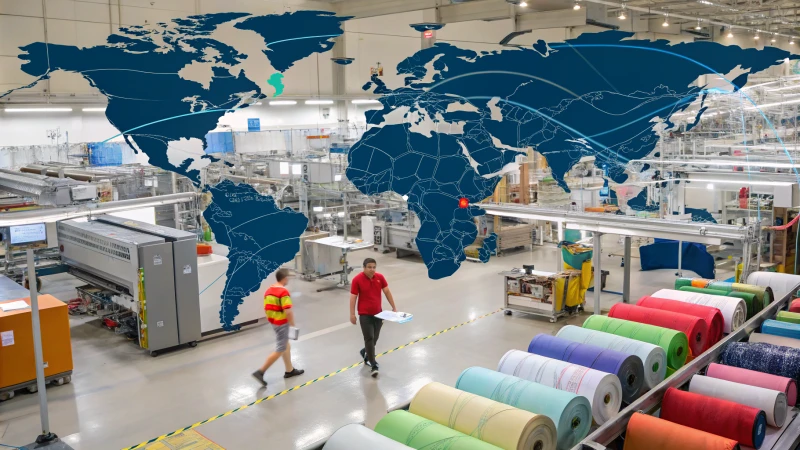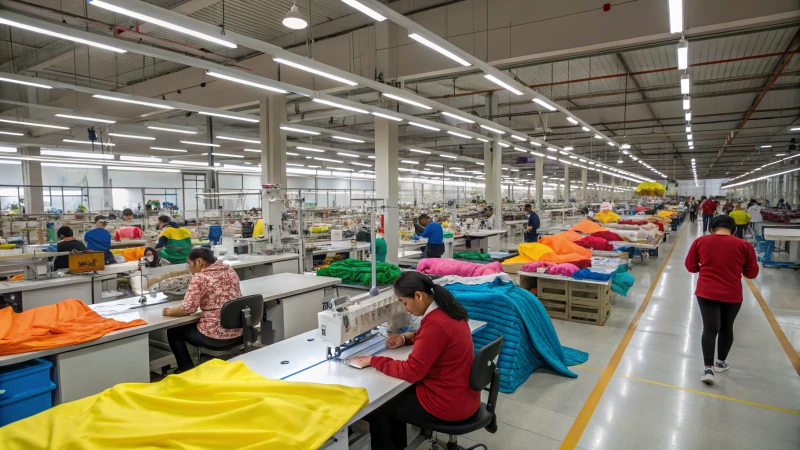
Creating a worldwide network for personalized underwear may seem difficult. Yet, it brings excitement with chances for new ideas and expansion. This journey teems with opportunities. Indeed, opportunities.
I first define my needs to create a worldwide supply chain for custom underwear. Reliable suppliers come next. Quality control follows closely. I improve logistics and vary my supplier choices. Technology helps a lot. Sustainability stays important. A very flexible supply chain results. It meets quality and market needs well.
I remember the first time I started this journey - it seemed like entering a world of endless opportunities. Every step, from picking fabrics that fit my brand's values to finding reliable partners who share my vision, was both hard and exciting. Choosing suppliers isn't only about price; it's about matching values and goals. Managing logistics became an art of balancing speed and cost, often needing creative solutions. Technology has a key role in changing my supply chain strategy, giving real-time insights and flexibility crucial in today's fast market. This journey has really strengthened my business. It also taught me important lessons about resilience and innovation.
Efficient logistics is crucial for a global supply chain.True
Logistics ensures timely delivery and cost-effectiveness in supply chains.
Supplier diversification weakens a supply chain.False
Diversifying suppliers reduces risk and enhances supply chain resilience.
What Are the Key Steps to Define Requirements for Custom Underwear?
When I chose to explore custom underwear design, an exciting journey awaited me. This journey brimmed with creativity and challenges. It felt like an adventure.
Defining requirements for custom underwear means choosing the right fabrics, setting size ranges and knowing style preferences. These needs should align with what your target group wants. It is important to understand this. The right fabric is essential.

Key Factors in Defining Requirements
I understood the importance of getting details right to help my brand shine. It was not only about choosing fabric or style but creating an identity that connected with my audience. Here are important factors I considered:
Fabric Selection: I searched for the ideal material, from the softest organic cotton to durable moisture-wicking fabrics. Each type had unique advantages, yet comfort and durability remained essential for my customers.
Size Range: Deciding on a size chart felt like planning for inclusivity. I wanted to accommodate all body types, providing sizes that made everyone feel considered. This meant offering more options and ensuring each piece felt just right.
Style Preferences: Whether classic boxers or sleek briefs, I aimed to offer styles appealing to diverse tastes. Finding a mix of trendy and timeless was vital so everyone found their favorite fit.
Color and Pattern Options: Playing with colors and patterns was fun, leading to a collection that felt new and matched seasonal trends. Feedback from friends and initial testers guided me toward colors that were bold and flattering universally.
Regulatory Standards: Handling textile regulations was challenging but necessary to have market-ready products in different places, like the EU and USA.
Creating Detailed Specifications
Detailed design specifications were necessary as I went into production. Careful planning improved communication with manufacturers, reducing mistakes and ensuring each item fit my vision.
| Component | Details |
|---|---|
| Material | Type of fabric, GSM, texture |
| Construction | Stitch type, seam placement |
| Measurements | Waist, rise, inseam |
| Accessories | Labels, tags, elastics |
By clearly laying out these details, I could keep consistency and uphold the promised quality of my brand.
Quality Standards and Testing
High quality standards were about trust. A rigorous testing protocol ensured each product met expectations for fabric strength, colorfastness, and fit. Collaborating with textile experts1 helped refine these processes consistently meeting promises.
Understanding Target Demographic Needs
Knowing my audience was crucial. Through market research and feedback, I focused on what mattered most to them - comfort, fit, and style. Prototypes went through tough testing with focus groups offering invaluable insights that shaped the final product line.
Leveraging Technology in Design
Technology became very helpful. CAD software let me perfect patterns with precision and 3D prototyping provided a sneak peek of the final product. This tech-savvy approach made the design process smoother ensuring each piece was just right before hitting the shelves.
Organic cotton is the only fabric for custom underwear.False
Other options include bamboo and performance fabrics, not just organic cotton.
Size range should cater to a broad audience.True
Offering extended sizes can appeal to a broader audience, enhancing inclusivity.
Where Can You Find Reliable Suppliers for Custom Underwear?
Locating trustworthy suppliers for custom underwear resembles a treasure hunt. People want quality and consistency. Where does one begin? Let me share some thoughts.
To find trustworthy suppliers for custom underwear, explore platforms like Alibaba. Attending trade shows often helps. Using industry directories frequently gives good results. Checking supplier reviews is very important. Request samples to see quality. Always ask for samples.

Explore Online Platforms
At the start of my custom underwear journey, endless hours went into exploring platforms like Alibaba2 and Global Sources. They felt like entering a massive market with limitless opportunities. These sites enabled me to sort suppliers by location, minimum order quantity, and ratings, which was crucial. It really helped me to narrow down choices.
| Platform | Features | Benefits |
|---|---|---|
| Alibaba | Wide supplier network, customer reviews | Diverse options, trust through ratings |
| Global Sources | In-depth supplier profiles, trade assurance | Ensures quality, secure transactions |
Attend Trade Shows
Trade shows opened my eyes. Imagine entering a lively fair like the Canton Fair3, surrounded by booths showcasing top products. Meeting suppliers in person gave me a clear idea of product quality and customization. Talking directly led to more personal connections and often better deals.
Utilize Industry Directories
Directories such as Fashiondex4 were priceless when I needed detailed manufacturer lists. They offered contact details and information on production capabilities. This helped with informed decisions without guessing.
Evaluate Supplier Credibility
I learned that checking supplier credibility is vital before any deals. Reading customer reviews and asking for product samples helped me avoid mistakes. Third-party audits checked if suppliers followed ethical and sustainable production standards.
- Check Reviews: Analyze feedback from clients to assess reliability.
- Request Samples: Testing samples for fabric quality and stitching was important.
- Conduct Audits: Use third-party services to verify compliance with industry standards.
Leverage Technology
Finally, using technology like supply chain management software changed my operations. Tools like Tradewind5 smoothed out logistics and improved efficiency in procurement, reducing errors significantly in order fulfillment.
By integrating these methods, I found suppliers who delivered top-quality custom underwear that fit my brand's needs perfectly. It wasn’t just about finding a supplier; it was forming a partnership that matched my vision.
Alibaba offers a wide network of custom underwear suppliers.True
Alibaba provides a vast directory of suppliers, including custom underwear.
Trade shows provide no opportunity to meet underwear suppliers.False
Trade shows like Canton Fair allow direct interaction with suppliers.
What Quality Control Measures Are Essential in Manufacturing?
Do you ever think about what keeps factory machines working perfectly? Factories operate efficiently to deliver top-quality products consistently.
Important quality control steps in factories involve creating clear guidelines, using process checks, doing regular inspections and applying statistical process control (SPC). These actions are critical. They help keep products the same, improve efficiency and reduce waste.

Setting Clear Standards
Setting quality standards feels like building a house's foundation. Without them, everything falls apart. I worked with a team to carefully define every detail, from materials to performance. For example, in electronics, checking resistor tolerances was vital. This careful attention made sure customers got exactly what we promised. Attention really mattered.
Establishing quality standards6 is the cornerstone of effective quality control in manufacturing. Standards must be clearly defined to ensure every stakeholder understands the requirements.
Implementing Process Controls
Process control works like a conductor in an orchestra. It keeps every part working in harmony. Techniques such as Six Sigma or Lean Manufacturing guide us like music sheets. I saw how these methods could change production. Automating temperature checks really improved consistency.
By applying these methodologies, manufacturers can optimize processes7 to reduce defects.
| Control Method | Description |
|---|---|
| Statistical Process Control (SPC) | Uses statistical methods to monitor and control production. |
| Total Quality Management (TQM) | Focuses on continuous improvement and customer satisfaction. |
Conducting Regular Inspections
Regular checks have saved us many problems later. Imagine finding a faulty brake early - like spotting a snag in your sweater at home. In the car industry, strict checks meet safety standards and avoid costly repairs.
Regular inspections are essential for detecting defects early in the manufacturing process.
For instance, automotive manufacturers often conduct rigorous inspections on components like engines and brakes to ensure safety standards are met.
Utilizing Statistical Process Control (SPC)
SPC is the core of precision in manufacturing. It uses data to fix problems before they grow.
Through SPC, manufacturers can make informed decisions based on real-time data analysis, which is crucial for maintaining consistent product quality.
I’ve used SPC in industries needing strict precision, like in pharmaceutical manufacturing8, where even small errors can be life-changing.
Clear standards reduce manufacturing defects.True
Defined standards align production with expectations, reducing errors.
Six Sigma is irrelevant to process control.False
Six Sigma enhances process control by minimizing inefficiencies.
How Can Technology Elevate Your Supply Chain Strategy?
Do you ever feel that your supply chain is a never-ending puzzle? I have experienced that too. Technology served as my bright beacon.
Technology really strengthens supply chain strategies. It provides real-time information. Operations become very efficient. Data helps in making decisions. Predictive analytics and IoT devices allow easy tracking. Automation increases smoothness and efficiency.

Real-Time Tracking and Visibility
I remember those days of waiting anxiously for shipment updates, with fingers crossed and hoping for the best. Using IoT devices9 in my supply chain felt like watching a live stream of products moving from creation to delivery. This view meant peaceful nights, knowing I was ready to face any problems like delays or inventory shortages head-on.
Predictive Analytics
Imagine this: it's December and you're not sure if you have enough stock for the holiday rush. Predictive analytics helps solve this uncertainty. By using predictive analytics10, I could use lots of data to foresee demand, avoid risks, and perfectly time inventory levels. This avoided waste and kept customers really happy.
Automation and Robotics
The first time watching an automated system sort and pack items was like a scene from a sci-fi movie. Adding automation and robotics in warehouses sped up work, reduced labor costs, and minimized errors. Technologies like automated guided vehicles11 (AGVs) made operations flow smoothly and efficiently.
Collaborative Platforms
Magic happens when everyone shares the same information. Cloud-based platforms allow easy collaboration among supply chain members. These tools give central data access, making supplier management really easy. Sharing forecasts, production plans, and shipment details became a harmonious and aligned effort.
Blockchain for Transparency
Trust is vital in business. Blockchain technology brings trust by securely recording transactions for transparency across the supply chain. With blockchain solutions12, verifying product authenticity and industry compliance became as simple as ticking a checklist. This was revolutionary for industries where quality is essential.
Accepting these technologies was not just following the trend; it redefined my supply chain, ensuring every part worked together to deliver excellence.
| Technology | Benefits |
|---|---|
| IoT Devices | Real-time monitoring |
| Predictive Analytics | Demand forecasting |
| Automation | Cost reduction |
| Collaborative Tools | Enhanced stakeholder alignment |
| Blockchain | Increased transparency |
IoT devices enable real-time shipment tracking.True
IoT devices provide continuous monitoring of goods, enhancing visibility.
Blockchain reduces supply chain transparency.False
Blockchain enhances transparency by securely recording transactions.
Conclusion
Building a global supply chain for custom underwear involves defining needs, sourcing reliable suppliers, ensuring quality control, optimizing logistics, leveraging technology, and maintaining sustainability.
Discover why textile quality testing is critical for maintaining product standards. ↩
Learn how to navigate Alibaba effectively to find trustworthy suppliers. ↩
Discover why attending the Canton Fair is beneficial for meeting potential suppliers. ↩
Access a comprehensive list of underwear suppliers through Fashiondex. ↩
Find out how Tradewind can help streamline your supply chain operations. ↩
Understanding quality standards helps ensure products meet customer and regulatory expectations. ↩
Discover ways to enhance efficiency and reduce defects in production. ↩
Explore how SPC helps maintain precision in pharmaceutical production. ↩
Learn how IoT devices provide real-time data, enhancing monitoring and efficiency in supply chains. ↩
Explore how predictive analytics enables better demand forecasting and inventory management. ↩
Discover how automation improves operational efficiency and accuracy in warehouses. ↩
See how blockchain ensures product authenticity and enhances transparency. ↩






